Vue normale
-
NYT > World News
-
William H. Webster, Who Ran Both the F.B.I. and the C.I.A., Dies at 101
A former federal judge, he first came to the F.B.I. just as two of the worst spies in American history were running rampant.
-
NYT > U.S. News
-
William H. Webster, Who Ran Both the F.B.I. and the C.I.A., Dies at 101
A former federal judge, he first came to the F.B.I. just as two of the worst spies in American history were running rampant.
William H. Webster, Who Ran Both the F.B.I. and the C.I.A., Dies at 101
-
Euromaidan Press
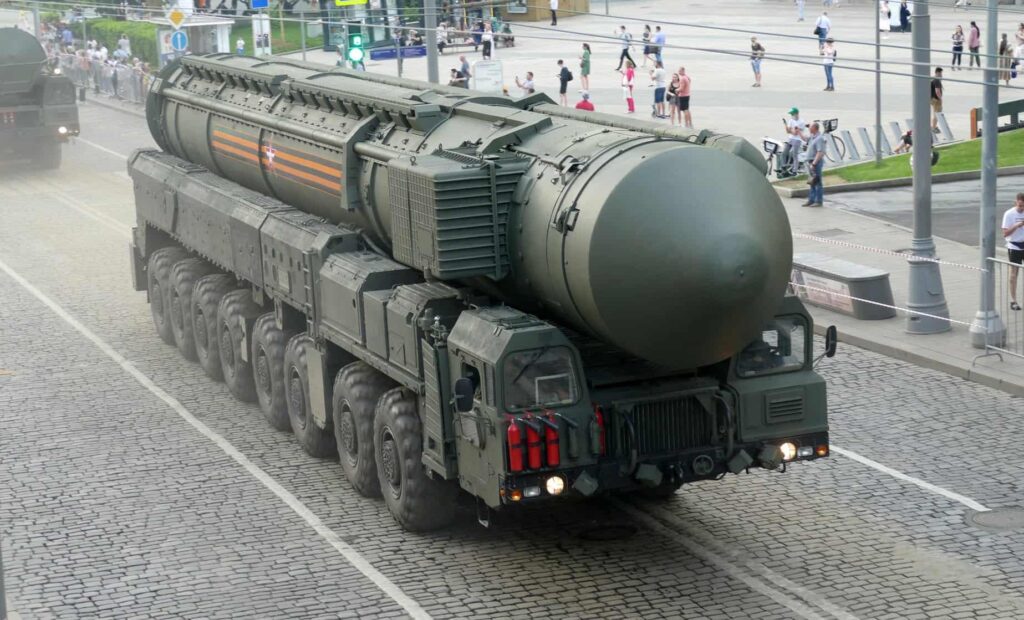
-
Russia may prepare to launch “flying Chornobyl” again—but only thing it has ever hit is its own scientists
Russia is likely preparing for new tests of the nuclear-powered missile Burevestnik, one of the five “superweapons” announced by Russian President Vladimir Putin in 2018. This missile, which the US has called “flying Chornobyl”, has never had a successful test flight, while its development remains hazardous to the environment, the Moscow Times reports. Putin claimed that Burevestnik is capable of “evading US missile defenses” due to its “almost unlimited range.” Ukrainian expert: Russia is tryi
Russia may prepare to launch “flying Chornobyl” again—but only thing it has ever hit is its own scientists

Russia is likely preparing for new tests of the nuclear-powered missile Burevestnik, one of the five “superweapons” announced by Russian President Vladimir Putin in 2018. This missile, which the US has called “flying Chornobyl”, has never had a successful test flight, while its development remains hazardous to the environment, the Moscow Times reports.
Ukrainian expert: Russia is trying again to “shake something in front of the world”
According to NV, retired Ukrainian colonel and pilot-instructor Roman Svitan believes that the rumors of Burevestnik tests are a Kremlin information operation aimed at intimidating the world.
He thinks the Kremlin uses this topic amid US internal politics and US Special Envoy Steve Witkoff’s talks with Putin on ending the war in Ukraine to showcase its nuclear might.
Earlier, US President Donald Trump ordered the deployment of two nuclear submarines after former Russian President Dmitry Medvedev’s statements, who on 31 July referenced the Soviet automatic nuclear system “Dead Hand” in the context of threats against the US. His statements came after Trump’s 10-day ultimatum that the US gave to Russia to end the war in Ukraine.
He points out serious technological failures not only with these missiles but also with the Oreshnik and Sarmat missiles.
“Russia is as far from the USSR as Kyiv is from a crawling beetle,” Svitan emphasizes.
Increased activity at the test site and radiation monitoring from the US
Nuclear weapons expert Decker Evelet reports increased activity at the Pankovo test range on the Novaya Zemlya archipelago — the primary testing ground for Burevestnik.
Simultaneously, the US deployed the WC-135R radiation reconnaissance aircraft to the region, indicating possible preparation for new missile tests.
According to Hans Kristensen of the Federation of American Scientists, these developments are a worrying sign.
The dark history of Burevestnik
The US intelligence data shows that as of October 2023, Russia conducted 13 tests of the missile, all of which failed. The longest flight lasted only two minutes with a maximum range of 35 km. A 2019 accident in the Barents Sea caused an explosion during a recovery operation, killing seven people, including nuclear scientists from the Sarov center.
The resulting radioactive contamination spread across northwest Russia and Scandinavia.
-
Euromaidan Press
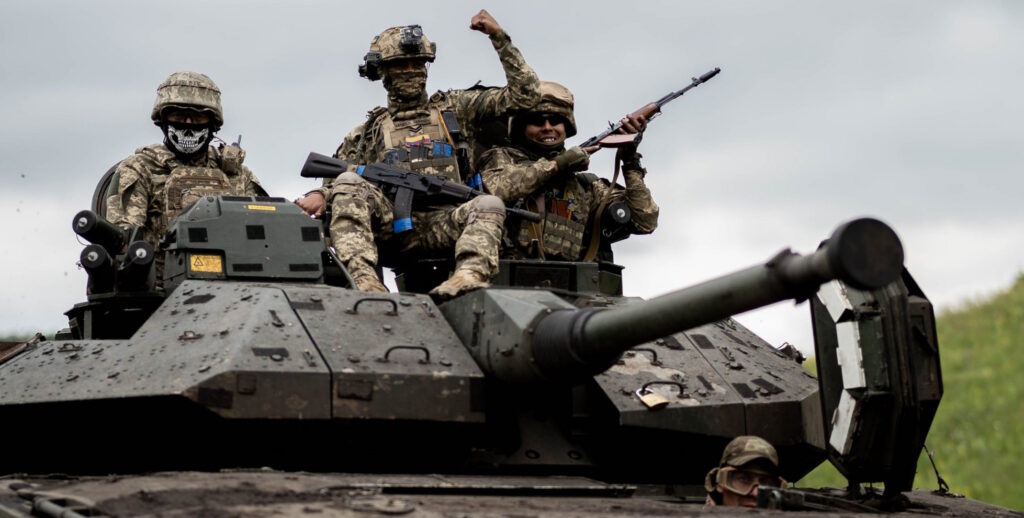
-
Ukraine’s special forces eliminate eight Russian companies in one rear operation
Ukraine’s Defense Intelligence “Timur” Special Unit has crashed Russia’s advance on Sumy Oblast. The fighters have eliminated eight Russian companies in Sumy Oblast, the agency reports. The Timur Special Unit has taken part in legendary operations, including: The liberation of Zmiinyi (Snake) Island, The recovery of energy assets in the Black Sea after the occupation of Crimea, The de-occupation of the Vovchansk Aggregate Plant in Kharkiv Oblast, Raids into Crimea and Enerhodar, Battles for B
Ukraine’s special forces eliminate eight Russian companies in one rear operation

Ukraine’s Defense Intelligence “Timur” Special Unit has crashed Russia’s advance on Sumy Oblast. The fighters have eliminated eight Russian companies in Sumy Oblast, the agency reports.
The Timur Special Unit has taken part in legendary operations, including:
- The liberation of Zmiinyi (Snake) Island,
- The recovery of energy assets in the Black Sea after the occupation of Crimea,
- The de-occupation of the Vovchansk Aggregate Plant in Kharkiv Oblast,
- Raids into Crimea and Enerhodar,
- Battles for Bakhmut and Avdiivka.
“The enemy’s advance has been halted. Their food and ammunition supply lines have been cut,” explains Ukraine’s military intelligence.
The operation involved 11 combat detachments under the Timur Special Unit. As a result of the mission:
- At least 334 Russian troops were eliminated
- Over 550 were wounded
Russians refuse to fight
According to the Defense Intelligence, Ukrainian soldiers executed a series of swift raids deep into Russian-controlled territory, effectively deploying FPV drones, artillery, grenade launchers, and small arms in close-quarters combat.
“Based on intercepted communications, Russian soldiers gave fabricated excuses to avoid storming positions within the Timur Unit’s area of operation,” says the agency.
A retaliatory strike against terror: Sumy under constant attack
In early August, Russia intensified its assaults on the Sumy front, launching frequent artillery, missile, and air strikes. In July alone, 23 civilians were killed, and over 140 were wounded, according to Oleh Hryhorov, head of the Sumy Regional Military Administration.
“In July, there were 2,700 Russian attacks on Sumy Oblast, with more than 800 air-dropped bombs, 250 kamikaze drone strikes, and 52 missile strikes,” Hryhorov says.
Read also
-
Most Germans say they won’t fight for their homeland, while Russia launches $1,1 trillion rearment program since Soviet Union
-
HUR: West still has not sanctioned 70 Russian companies behind production of missiles that struck Kyiv’s largest children’s cancer hospital year ago
-
India helps Russia to increase Ukrainian civilian death rate with octogen explosives exports worth $1,5 million

Thanks to your incredible support, we’ve raised 70% of our funding goal to launch a platform connecting Ukraine’s defense tech with the world – David vs. Goliath defense blog. It will support Ukrainian engineers who are creating innovative battlefield solutions and we are inviting you to join us on the journey.
Our platform will showcase the Ukrainian defense tech underdogs who are Ukraine’s hope to win in the war against Russia, giving them the much-needed visibility to connect them with crucial expertise, funding, and international support.
We’re one final push away from making this platform a reality.
-
Euromaidan Press
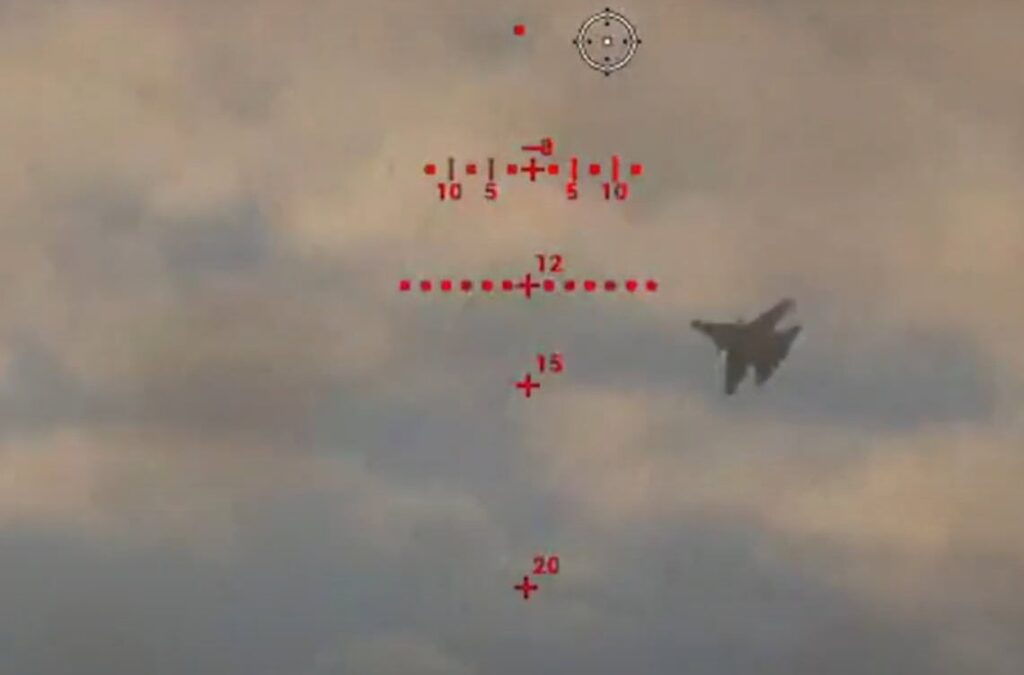
-
Ukraine’s Security Service obliterates Russian $50 million Su-30 jet in Crimea—and damages more
Ukraine has unleashed hell on the occupiers. During the night of 4 August, Ukrainian drones launched a powerful strike on a Russian-occupied airbase in Crimea. One of Russia’s most advanced tactical fighter jets was completely destroyed, and four more aircraft were hit, the Security Service (SBU) reports. Russian aircraft based near Ukraine is capable of carrying guided bombs. In 2025, Russia plans to produce 75,000 aerial bombs equipped with glide and correction modules, which turn a standard
Ukraine’s Security Service obliterates Russian $50 million Su-30 jet in Crimea—and damages more

Ukraine has unleashed hell on the occupiers. During the night of 4 August, Ukrainian drones launched a powerful strike on a Russian-occupied airbase in Crimea. One of Russia’s most advanced tactical fighter jets was completely destroyed, and four more aircraft were hit, the Security Service (SBU) reports.
Russian aircraft based near Ukraine is capable of carrying guided bombs. In 2025, Russia plans to produce 75,000 aerial bombs equipped with glide and correction modules, which turn a standard unguided bomb into a precision-guided munition with an extended range. The new number represents Moscow’s plans for a 50% increase in guided bombs production output.
What did the SBU destroy?
The target of the operation was one of Russia’s main airbases in temporarily occupied Crimea, the Saky military airfield, from which enemy planes take off to strike southern Ukraine and ships in the Black Sea. The base hosts strategic bombers and reconnaissance aircraft. The airfield lies nearly 70-80 kilometers from Ukraine-controlled territory.
The SBU’s “Alpha” Special Center used drones to deliver precision strikes on Russian equipment. As a result of the special operation:
- One Su-30SM fighter jet was completely destroyed
- One more Su-30SM was damaged
- Three Su-24 strike aircraft were hit
A warehouse containing aviation munitions was incinerated.
Russian losses: Tens of millions of dollars go up in smoke in Crimea
The Russians lost at least one Su-30SM, valued at $50 million. These fighters can carry up to 8 tons of bombs and missiles and have a combat radius of up to 1,500 km.
Several Su-24 aircraft were also damaged. These are used for precision strikes on ground targets, with a combat radius of around 560 km. Russia’s losses may reach tens of millions of dollars.
“Occupiers will never feel safe”
The Security Service of Ukraine confirmed the strike, emphasizing that the operation is a key part of the strategy to destroy enemy logistics and combat capabilities in Crimea.
“Occupiers must remember they will never feel safe on our land!” the SBU stated.

Thanks to your incredible support, we’ve raised 70% of our funding goal to launch a platform connecting Ukraine’s defense tech with the world – David vs. Goliath defense blog. It will support Ukrainian engineers who are creating innovative battlefield solutions and we are inviting you to join us on the journey.
Our platform will showcase the Ukrainian defense tech underdogs who are Ukraine’s hope to win in the war against Russia, giving them the much-needed visibility to connect them with crucial expertise, funding, and international support.
We’re one final push away from making this platform a reality.
-
Euromaidan Press
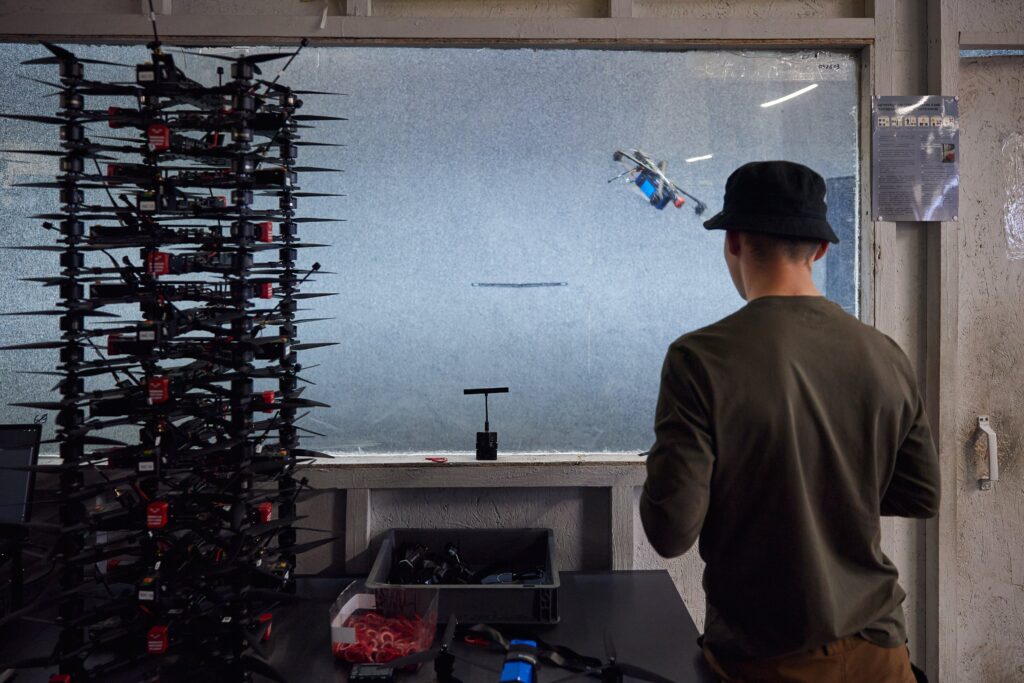
-
US tech giants land in Kyiv to outsmart Russia’s deadly drones
Global tech giants come to Kyiv. Deputy Defense Minister Serhii Boiev has held talks in Kyiv with Axon founder and CEO Rick Smith and head of Dedrone by Axon, Aaditya Devarakonda, Ukraine’s Defense Ministry reports. The integration of Ukrainian military technologies amid Russia’s war of attrition is becoming a key factor in the country’s survival. Ukrainian engineers are implementing real-time reconnaissance systems, artificial intelligence, and robotic unmanned platforms. The main topic has
US tech giants land in Kyiv to outsmart Russia’s deadly drones

Global tech giants come to Kyiv. Deputy Defense Minister Serhii Boiev has held talks in Kyiv with Axon founder and CEO Rick Smith and head of Dedrone by Axon, Aaditya Devarakonda, Ukraine’s Defense Ministry reports.
The integration of Ukrainian military technologies amid Russia’s war of attrition is becoming a key factor in the country’s survival. Ukrainian engineers are implementing real-time reconnaissance systems, artificial intelligence, and robotic unmanned platforms.
The main topic has been the joint fight against enemy UAVs (drones), technology exchange, and scaling production of electronic warfare tools and drone interceptors.
“We are most interested in electronic warfare (EW) technologies and drone interceptors,” says Boiev.
During the meeting, Axon CEO Rick Smith told the Ukrainian officials that “our offer is not about business but about protecting people.”
Axon and Dedrone move to cooperate with Ukrainian manufacturers
Axon is a US leader in public safety, known for TASER stun guns, body cameras, digital platforms, and evidence analysis software, used by police and security agencies in many countries.
Dedrone by Axon specializes in airspace protection from unauthorized drones. Its technology operates in over 50 countries — in prisons, stadiums, airports, and even military units.
Dedrone uses artificial intelligence and machine learning to detect, track, and neutralize drones. The system integrates data from radars, radio frequencies, and video cameras into a unified C2 platform — either local or cloud-based.
Ukraine as a hub for new military solutions
Kyiv already cooperates with domestic companies to ramp up production of drone countermeasure systems, but according to Boiev, they “continue searching for new solutions.”
-
Euromaidan Press

-
Ukraine destroys Russian electronic warfare hub in occupied area of Black Sea, sets up Ukrainian flag
Ukrainian special forces landed on a Russian-controlled island in the Black Sea on 28 July night and wiped out the entire garrison without any Ukrainian casualties. The target? Tendrivska Spit, a 65-kilometer sliver of land jutting into the Black Sea near occupied Kherson. Why this particular piece of sand and scrub? The Russians had turned it into an electronic warfare hub. Ukraine’s Main Intelligence Directorate says their commandos destroyed a “Zont” jamming complex and a “Rosa” radar s
Ukraine destroys Russian electronic warfare hub in occupied area of Black Sea, sets up Ukrainian flag

Ukrainian special forces landed on a Russian-controlled island in the Black Sea on 28 July night and wiped out the entire garrison without any Ukrainian casualties.
The target? Tendrivska Spit, a 65-kilometer sliver of land jutting into the Black Sea near occupied Kherson. Why this particular piece of sand and scrub?
The Russians had turned it into an electronic warfare hub. Ukraine’s Main Intelligence Directorate says their commandos destroyed a “Zont” jamming complex and a “Rosa” radar station along with the troops manning them.
Here’s what makes this operation notable: Tendrivska Spit sits in contested waters where both sides have been trading blows for months. The narrow island—barely 1.8 kilometers wide at its broadest point—gave Russian forces eyes and electronic ears across a significant chunk of the northern Black Sea.
Not anymore. Ukrainian intelligence released footage showing their blue and yellow flag flying over the position.
Ukraine captures strategic island in the Black Sea after eliminating the entire Russian garrison in a daring nighttime raid — Ukraine's intelligence.
— Euromaidan Press (@EuromaidanPress) July 30, 2025
The special forces assault on Tendrivska Spit destroyed sophisticated Russian electronic warfare equipment—including a "Zont"… pic.twitter.com/88rs6vhbfo
How did they pull it off? The operation relied on boats funded through a private initiative called “Boats for HUR,” run by the Ukrainian Diana Podolyanchuk Charitable Foundation. International donors helped pay for the watercraft that carried the assault team to their target.
The timing matters. Ukrainian forces have been systematically targeting Russian positions on isolated islands and coastal areas, using their advantage in small boat operations. Each successful raid forces Russia to commit more resources to defending scattered outposts.
Can Russia replace what they lost? The electronic warfare equipment destroyed in the raid represents sophisticated gear that takes months to produce and deploy. The radar station gave Russian forces advance warning of Ukrainian naval movements—a capability now gone.
The operation signals Ukraine’s growing confidence in conducting amphibious raids deep behind Russian lines. Previous strikes hit Zmiinyi (Snake) Island and other Black Sea positions, but Tendrivska Spit sits closer to the Ukrainian mainland, suggesting expanded operational reach.
-
Euromaidan Press

-
Ukraine’s cyber warriors crush Russian control systems in Crimea, steal 100TB of secrets
Ukrainian military intelligence cyber specialists have carried out a powerful operation against Russian authorities in occupied Crimea. According to RBC-Ukraine’s intelligence sources, the cyberattack lasted several days and paralyzed the entire digital infrastructure of the occupation administration. Russia is transforming occupied Ukrainian regions into military bases. Moscow troops use Donetsk and Luhansk oblasts to build up combat units, establish fortified positions, and organize logistics
Ukraine’s cyber warriors crush Russian control systems in Crimea, steal 100TB of secrets

Ukrainian military intelligence cyber specialists have carried out a powerful operation against Russian authorities in occupied Crimea. According to RBC-Ukraine’s intelligence sources, the cyberattack lasted several days and paralyzed the entire digital infrastructure of the occupation administration.
Russia is transforming occupied Ukrainian regions into military bases. Moscow troops use Donetsk and Luhansk oblasts to build up combat units, establish fortified positions, and organize logistics hubs. Meanwhile, from occupied Crimea, Russian forces are launching missiles and drones at other Ukrainian cities.
It began with a powerful DDoS assault that took down the occupiers’ government services. While panic spread in Crimea and technicians scrambled to identify the source of the outage, Ukrainian hackers had already infiltrated the electronic accounts of the so-called “authorities.” And that was just the beginning.
100 terabytes stolen, systems destroyed
The Ukrainian Defence Intelligence has gained access to the occupiers’ key digital systems:
- DIALOG,
- SED,
- Delo,
- accounting systems including 1C:Document Management”, Directum, and ATLAS.
In just two days, over 100 terabytes of classified information were downloaded. Among the documents were files marked as top secret, including data on military facilities and logistics for supplying Russian troops.
After completing the operation, HUR specialists destroyed all the occupiers’ administrative servers, at both regional and district levels. These structures have effectively lost access to their documents, databases, and internal communications.
Panic in Moscow, chaos in Crimea
“So much data was extracted that we’ll soon uncover plenty of sensational details about Russian crimes in Crimea. Special thanks for the assistance goes to the deputy minister of health of the occupation government, Anton Lyaskovsky,” an intelligence source told RBC-Ukraine with irony.
Moscow has already labeled the operation as “elements of hybrid warfare.” Meanwhile, the so-called “Ministry of Internal Policy” of Crimea has admitted that some services remain offline. However, the true scale of the destruction is only beginning to come to light.
Read also
-
Russians in Crimea pack up as relentless sound of air alerts and sight of tanks become their new reality
-
Ukraine hits Russian S-300P launcher, Nebo-M radar, and Big Bird node in Belgorod Oblast (video)
-
Russians in Crimea pack up as relentless sound of air alerts and sight of tanks become their new reality
-
Ukraine’s Defense Intelligence: Russia loots ancient treasures from Crimea’s UNESCO heritage site
-
Euromaidan Press

-
Kyiv court arrests suspected Russian spy embedded in anti-graft bureau
A suspected Russian spy in Ukraine’s national anti-graft bureau was arrested in Kyiv after security officials accused him of leaking restricted data to Russian intelligence via a traitor tied to fugitive ex-president Viktor Yanukovych. Liga reports that the Shevchenkivskyi District Court in Kyiv ordered the officer’s pretrial detention without bail until 20 September. Anti-graft bureau officer suspected of spying for Russia Liga, citing a law enforcement source, reports that the arrested individ
Kyiv court arrests suspected Russian spy embedded in anti-graft bureau

A suspected Russian spy in Ukraine’s national anti-graft bureau was arrested in Kyiv after security officials accused him of leaking restricted data to Russian intelligence via a traitor tied to fugitive ex-president Viktor Yanukovych. Liga reports that the Shevchenkivskyi District Court in Kyiv ordered the officer’s pretrial detention without bail until 20 September.
Anti-graft bureau officer suspected of spying for Russia
Liga, citing a law enforcement source, reports that the arrested individual is Viktor Husarov, an officer from the D-2 closed unit within the central office of the National Anti-Corruption Bureau of Ukraine (NABU). He was detained by the Security Service of Ukraine (SBU) on 21 July.
According to the Prosecutor General’s Office, the suspect allegedly carried out espionage on behalf of Russia’s Federal Security Service (FSB). Investigators claim he passed information about Ukrainian law enforcement officials and civilians to Russian intelligence through an intermediary. That intermediary, the office said, was Dmytro Ivantsov — a known traitor and former deputy head of personal security for Yanukovych, who assisted the former president’s escape to Russia in February 2014.
The Prosecutor General’s Office confirmed that at least 60 episodes of transmitting restricted information had been documented.
“For each such transmission, the NABU officer received funds to his bank card,” prosecutors added.
The officer has been officially charged with state treason and unauthorized actions involving restricted information committed by a person with authorized access.
SBU operation aimed to neutralize Russian penetration of NABU
On 21 July, the SBU and the Prosecutor General’s Office announced the launch of a special operation to disrupt Russian infiltration within NABU. The agencies stated they had detained a staff member of the central apparatus of NABU suspected of spying for Russia.
NABU said that it had earlier received a warning in August 2023 from SBU leadership about potential risks involving the suspect. The agency said it initiated an internal interview process to evaluate possible disciplinary action or dismissal. However, according to NABU, the SBU advised it not to proceed in order to avoid interfering with an ongoing counterintelligence operation targeting other individuals connected to the traitor.
Read also
-
Abuse of power: Ukraine’s Civil Anti-Corruption Council urges Zelenskyy to veto new law undermining anti-corruption system
-
Western trust under threat as Zelenskyy nears signing controversial law that crashes Ukraine’s anti-corruption system
-
Security service officials took $300,000 bribes as Ukraine guts corruption oversight
-
SBU: Russian “mole” in Ukraine’s Anti-Corruption Bureau spied for FSB under former President Yanukovych’s security chief
-
Euromaidan Press
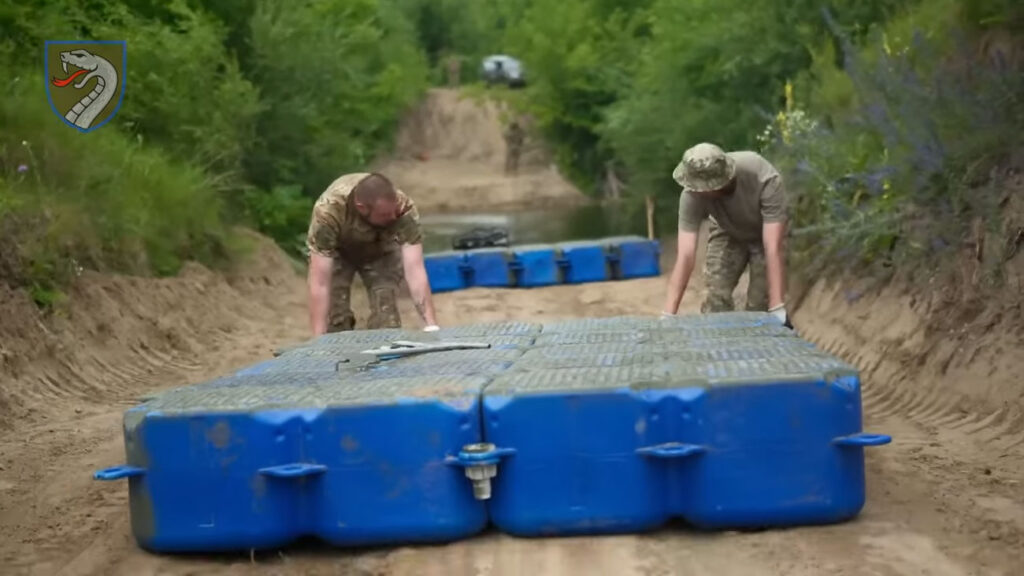
-
Ukraine’s new 15-minute bridges: Plastic cubes, no delay, full mobility (video)
Engineers from Ukraine’s Steppe Brigade are fielding modular plastic bridges that deploy in just 15 minutes, giving troops rapid mobility across rivers in active combat zones. This rapid frontline bridge deployment offers a major tactical edge as Ukrainian units face constant maneuver demands on the front. Plastic cubes reshape how Ukraine crosses rivers under fire Militarnyi reports that the 61st “Steppe” Mechanized Brigade has begun using a new system of plastic pontoon bridges composed of mod
Ukraine’s new 15-minute bridges: Plastic cubes, no delay, full mobility (video)

Engineers from Ukraine’s Steppe Brigade are fielding modular plastic bridges that deploy in just 15 minutes, giving troops rapid mobility across rivers in active combat zones. This rapid frontline bridge deployment offers a major tactical edge as Ukrainian units face constant maneuver demands on the front.
Plastic cubes reshape how Ukraine crosses rivers under fire
Militarnyi reports that the 61st “Steppe” Mechanized Brigade has begun using a new system of plastic pontoon bridges composed of modular floating cubes. The brigade reported that the system has already shown its effectiveness at multiple positions along the frontline. It was first used during the Kursk operation in Russia, where it allowed fast movement of infantry and light vehicles.
Brigade engineers say the system’s greatest strengths are its speed and adaptability. The plastic pontoon bridge is designed to transport infantry and light equipment.
“Mobility, fast deployment, and structural reliability let our units stay one step ahead of the enemy,” the brigade noted.
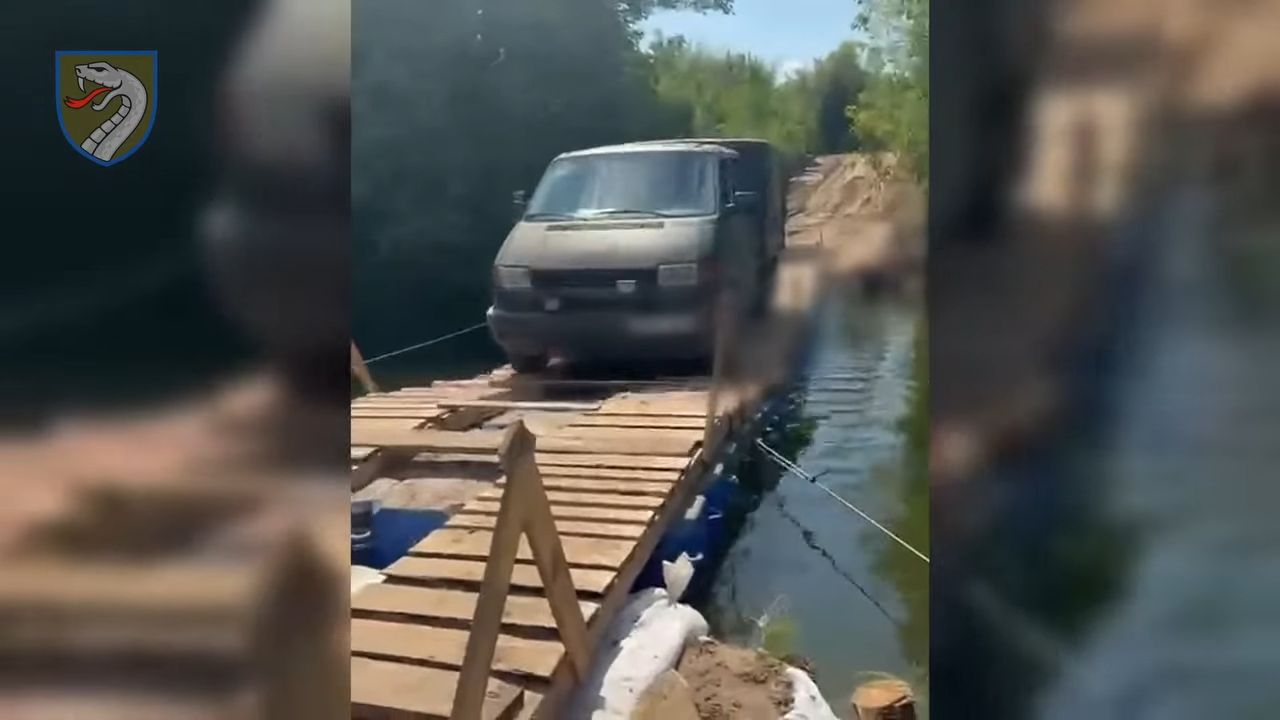
Each pontoon crossing is constructed from interlocking plastic modules that float independently and connect through a specialized fastening system. This design makes it easy to change the length or shape of the bridge and replace any damaged cubes after shelling.
Stormproof, fast, and modular — built to survive war zones
The plastic cubes are produced by a Ukrainian manufacturer, which emphasizes the system’s ability to work in any location and under any weather conditions.
“Our floating structures can be used in any region and on any water body. They are easy to assemble, even in adverse weather,” the manufacturer stated.
The construction is resistant to freezing, tidal surges, and storm conditions. It also does not freeze into ice during winter, a key feature for year-round combat use. For vehicle crossings, engineers add wooden decking to support the weight of light military equipment.
-
Euromaidan Press
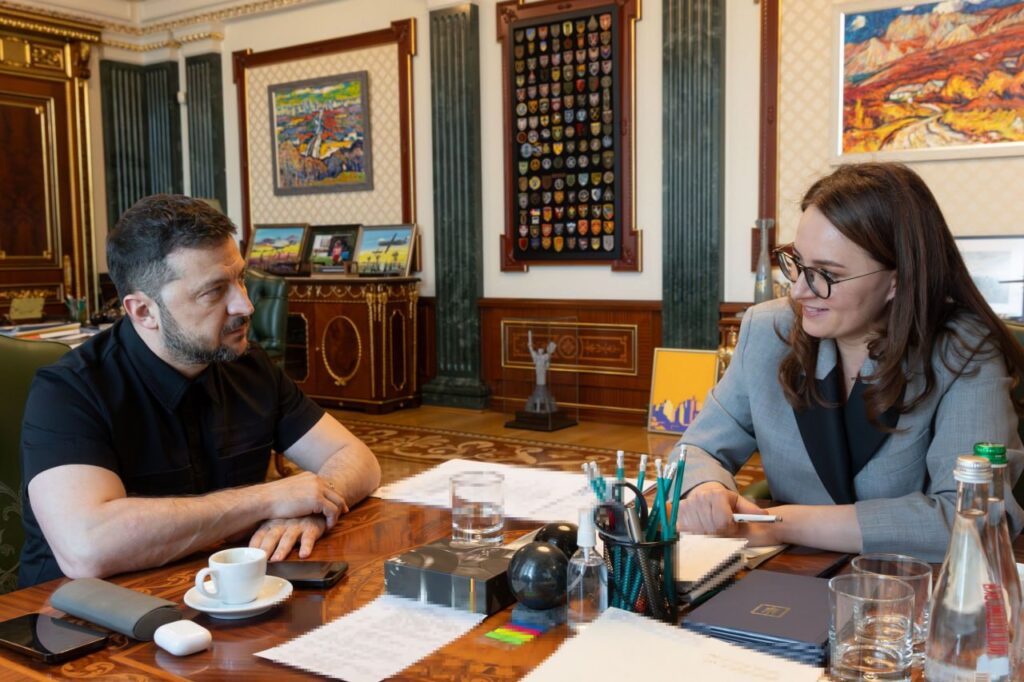
-
New Ukrainian PM Svyrydenko: Kyiv, Washington to launch joint drone deal under Trump-Zelenskyy mega pact
The US plans to invest in the production of Ukrainian drones. New Prime Minister Yuliia Svyrydenko has announced that Ukraine intends to sign a drone agreement with American partners, Reuters reports. Drone warfare has defined the Russo-Ukrainian war, with unmanned systems deployed across air, land, and sea. Ukraine and Russia remain locked in a fast-paced arms race, constantly advancing their drone technologies and testing new offensive and defensive systems. “We plan to sign a ‘drone deal’ wi
New Ukrainian PM Svyrydenko: Kyiv, Washington to launch joint drone deal under Trump-Zelenskyy mega pact

The US plans to invest in the production of Ukrainian drones. New Prime Minister Yuliia Svyrydenko has announced that Ukraine intends to sign a drone agreement with American partners, Reuters reports.
“We plan to sign a ‘drone deal’ with the United States. We are discussing investments in the expansion of production of Ukrainian drones by the US,” says Svyrydenko.
The official has clarified that the deal involves the purchase of a large batch of Ukrainian unmanned aerial vehicles.
Svyrydenko added that Ukrainian President Volodymyr Zelenskyy and US President Donald Trump made the political decision on the agreement earlier, and officials are now discussing its details.
Earlier, Euromaidan Press reported that both leaders were considering what’s being called a “mega deal.” Under the proposed agreement, Kyiv would sell its combat-hardened drone systems to Washington. In return, it would sell Ukraine a significant array of American weapons.
Zelenskyy emphasized that Ukraine is ready to share its knowledge gained from over three years of fighting against Russia’s full-scale invasion.
-
Euromaidan Press
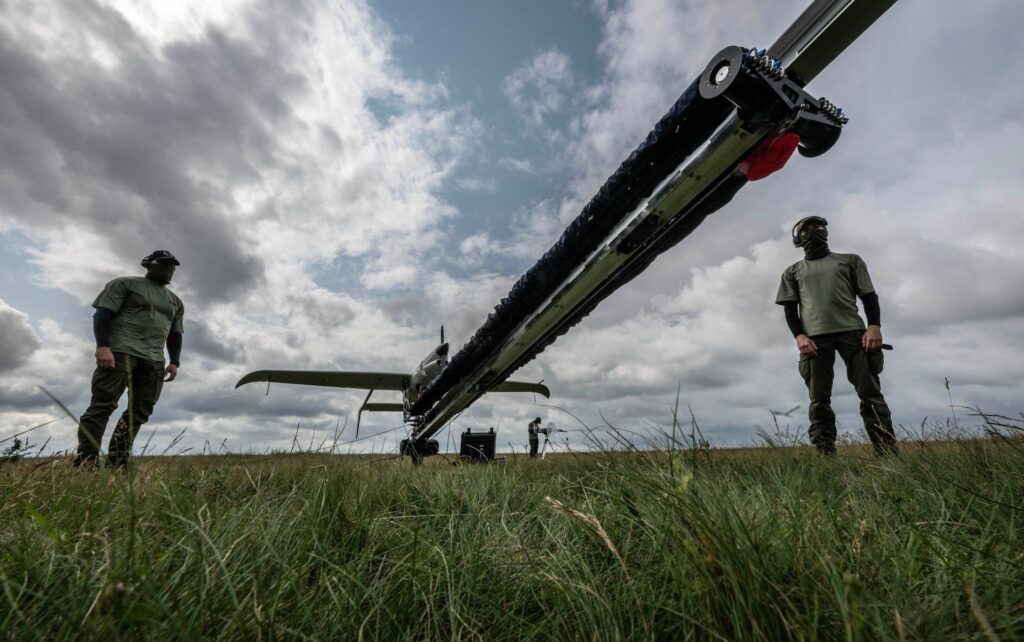
-
Romania wants to build drones with Ukraine—but can’t fund it before 2026
Romania wants to build drones with Ukraine, but production is delayed until 2026 due to lack of military funding. Digi24 reports that Romania’s Defense Ministry wants to launch a joint drone-manufacturing project, but no funds are available this year to begin construction or procurement. Drone warfare has shaped the Russo-Ukrainian conflict, with Ukraine deploying UAVs across all domains. The ongoing Russian invasion has driven a surge in Ukrainian drone production, and the Ministry of Defense r
Romania wants to build drones with Ukraine—but can’t fund it before 2026

Romania wants to build drones with Ukraine, but production is delayed until 2026 due to lack of military funding. Digi24 reports that Romania’s Defense Ministry wants to launch a joint drone-manufacturing project, but no funds are available this year to begin construction or procurement.
Romania wants to build drones with Ukraine, but budget delay blocks start
Romania wants to build drones with Ukraine, aiming to manufacture UAVs inside Romania and eventually export them to other European countries. Digi24 reports that the Romanian Ministry of Defense has confirmed it is set to negotiate with officials from Kyiv. The two sides aim to establish a co-production plan for drones, following models already used by Ukraine in partnerships with Denmark and Norway.
According to Digi24, the business plan is not complex: Romania would purchase the technical specifications of drones that Ukraine has developed during its war experience. Those designs, proven in combat, would serve as the base for production inside Romania.
The proposed facility would likely be located in Brașov, Transylvania. Romanian and Ukrainian engineers would cooperate on-site to assemble the UAVs. Most of the drones would enter service with the Romanian army, but many would also be intended for sale across Europe, per the reported plan.
Factory plan awaits funding, likely in 2026
Despite alignment on the concept, the project faces a major obstacle: Romania currently lacks the funding to implement it. Digi24 notes that while Ukraine is willing to move forward and eager to secure income from such cooperation, Romania cannot commit to payments this year.
The next opportunity to fund the drone partnership would come with Romania’s 2026 defense budget. Until then, the joint production initiative remains in the planning phase.
-
Euromaidan Press

-
Switzerland’s Patriot air defense systems delivery delayed by US — Ukraine’s urgent need takes priority amid rising civilian deaths
The Swiss Ministry of Defense reports that the US is delaying deliveries of Patriot air defense systems ordered by Switzerland due to priority support for Ukraine in its war against Russia. Ukraine needs Patriot air defense systems and missiles to them to intercept Russian ballistic missiles. Moscow has intensified its aerial terror against civilians, launching sometimes over 700 drones per night. Russian attacks have resulted in an increased number of civilian deaths, with the UN reporting tha
Switzerland’s Patriot air defense systems delivery delayed by US — Ukraine’s urgent need takes priority amid rising civilian deaths

The Swiss Ministry of Defense reports that the US is delaying deliveries of Patriot air defense systems ordered by Switzerland due to priority support for Ukraine in its war against Russia.
Ukraine needs Patriot air defense systems and missiles to them to intercept Russian ballistic missiles. Moscow has intensified its aerial terror against civilians, launching sometimes over 700 drones per night. Russian attacks have resulted in an increased number of civilian deaths, with the UN reporting that in June alone, Moscow killed 232 people, including women and children.
In 2022, Switzerland ordered five Patriot systems, which were planned for delivery between 2026 and 2028. However, on 16 July 2025, the US officially announced a revision of delivery priorities due to the urgent need to replenish armaments for countries supplying weapons to Ukraine.
According to Defense Express, the contract included the delivery of 17 launchers and a stock of 70 GEM-T surface-to-air missiles, five AN/MPQ-65 radars, six MIDS-LVT data distribution systems, and five AN/MSQ-132 command posts.
Additionally, in November 2022, the US State Department approved the supply of 72 PAC-3 MSE missiles and related equipment to Switzerland worth $700 million.
Switzerland will receive the systems from later production batches, resulting in delivery delays. Meanwhile, Germany has increased its aid to Ukraine by transferring an additional two Patriot systems.
The delay currently has no specific timeline, and it is unclear whether it will affect deliveries of the PAC-3 MSE guided missiles, which the US promised to provide Ukraine earlier than Switzerland last year.
